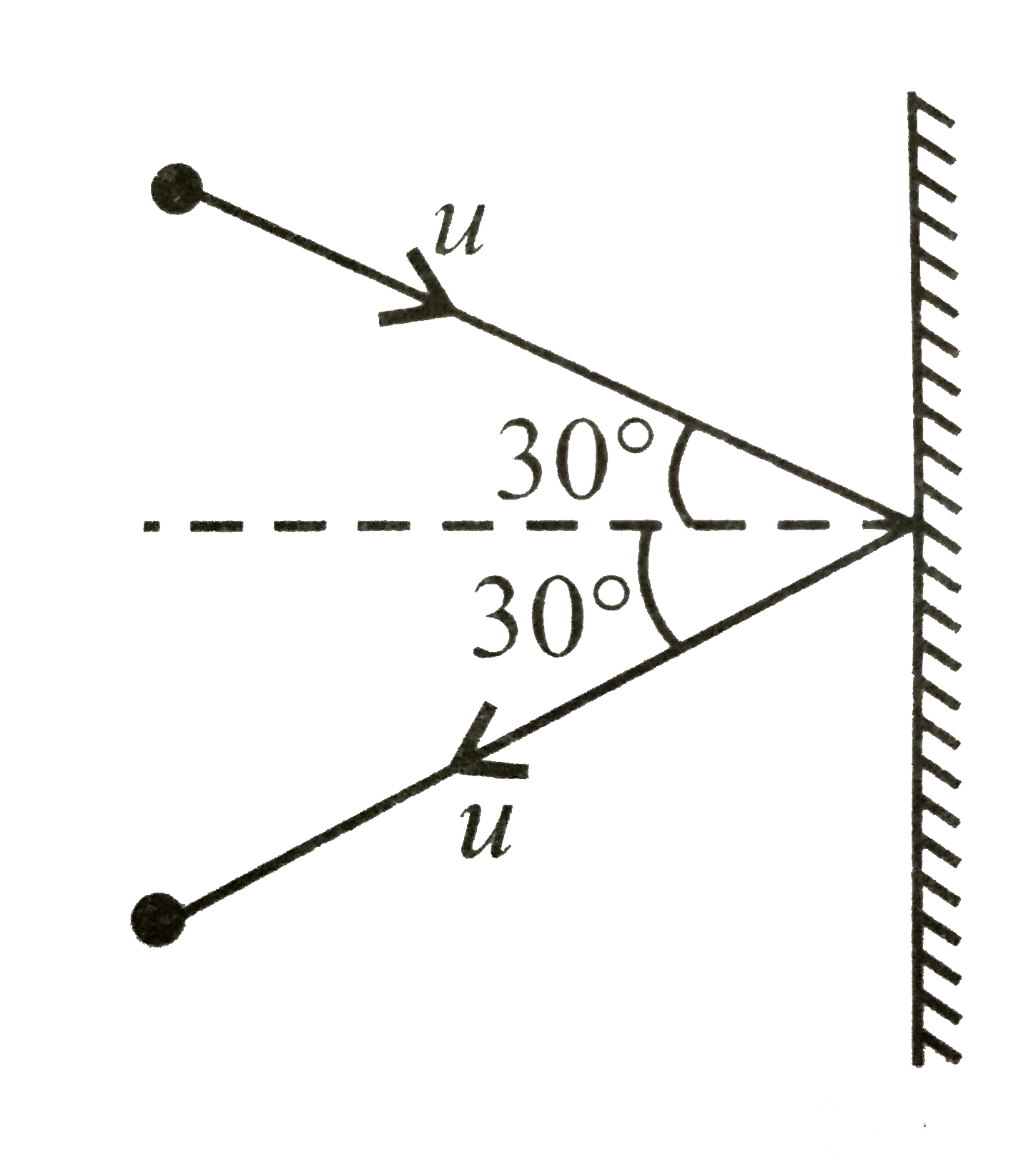A 10g rubber ball and a 10g clay ball are each thrown at a wall with equal speeds. The rubber ball bounces, the clay ball sticks. Which ball receives a greater impulse from the wall ?
The clay ball recieves a greater impulse because it sicks.
The rubber ball receive a greater impulse because it bounces.
They receive equal impulses because they have equal momenta.
Neither receives an impulse because the wall doesn't move.
The correct Answer is:B
To determine which ball receives a greater impulse from the wall, we can analyze the situation using the principles of momentum and impulse.
1. Understanding Impulse:
Impulse is defined as the change in momentum of an object when a force is applied over a period of time. Mathematically, impulse (I) can be expressed as:
I=Δp=pf−pi
where pf is the final momentum and pi is the initial momentum.
2. Initial Momentum Calculation:
For both the rubber ball and the clay ball, they have the same mass m=10g=0.01kg and are thrown at the same speed vi. The initial momentum for both balls is:
pi=m⋅vi
3. Final Momentum for the Rubber Ball:
When the rubber ball hits the wall, it bounces back. If we assume it bounces back with the same speed but in the opposite direction, its final momentum pf will be:
pf=m⋅(−vi)=−m⋅vi
Thus, the change in momentum (impulse) for the rubber ball I1 is:
I1=pf−pi=(−m⋅vi)−(m⋅vi)=−2m⋅vi
4. Final Momentum for the Clay Ball:
The clay ball sticks to the wall, so its final momentum pf is 0. Therefore, the impulse I2 for the clay ball is:
I2=pf−pi=0−(m⋅vi)=−m⋅vi
5. Comparing Impulses:
Now we can compare the impulses received by both balls:
- For the rubber ball:
I1=−2m⋅vi
- For the clay ball:
I2=−m⋅vi
Since −2m⋅vi<−m⋅vi, we conclude that:
|I1|>|I2|
This indicates that the rubber ball receives a greater impulse from the wall than the clay ball.
Conclusion:
The rubber ball receives a greater impulse from the wall because it bounces back, resulting in a larger change in momentum compared to the clay ball, which sticks to the wall.
Impulse is defined as the change in momentum of an object when a force is applied over a period of time. Mathematically, impulse (I) can be expressed as:
I=Δp=pf−pi
where pf is the final momentum and pi is the initial momentum.
For both the rubber ball and the clay ball, they have the same mass m=10g=0.01kg and are thrown at the same speed vi. The initial momentum for both balls is:
pi=m⋅vi
When the rubber ball hits the wall, it bounces back. If we assume it bounces back with the same speed but in the opposite direction, its final momentum pf will be:
pf=m⋅(−vi)=−m⋅vi
Thus, the change in momentum (impulse) for the rubber ball I1 is:
I1=pf−pi=(−m⋅vi)−(m⋅vi)=−2m⋅vi
The clay ball sticks to the wall, so its final momentum pf is 0. Therefore, the impulse I2 for the clay ball is:
I2=pf−pi=0−(m⋅vi)=−m⋅vi
Now we can compare the impulses received by both balls:
- For the rubber ball:
I1=−2m⋅vi
- For the clay ball:
I2=−m⋅vi
Since −2m⋅vi<−m⋅vi, we conclude that:
|I1|>|I2|
This indicates that the rubber ball receives a greater impulse from the wall than the clay ball.
The rubber ball receives a greater impulse from the wall because it bounces back, resulting in a larger change in momentum compared to the clay ball, which sticks to the wall.
Topper's Solved these Questions
- CENTRE OF MASSBOOK - ALLENCHAPTER - CENTRE OF MASSEXERCISE - EXERCISE-II
43 Videos
- CENTRE OF MASSBOOK - ALLENCHAPTER - CENTRE OF MASSEXERCISE - EXERCISE-III
42 Videos
- CENTRE OF MASSBOOK - ALLENCHAPTER - CENTRE OF MASSEXERCISE - EXERCISE-V B
19 Videos
- BASIC MATHEMATICS USED IN PHYSICS &VECTORS BOOK - ALLENCHAPTER - BASIC MATHEMATICS USED IN PHYSICS &VECTORS EXERCISE - EXERCISE-IV ASSERTION & REASON
11 Videos
- ELASTICITY, SURFACE TENSION AND FLUID MECHANICSBOOK - ALLENCHAPTER - ELASTICITY, SURFACE TENSION AND FLUID MECHANICSEXERCISE - Exercise 5 B (Integer Type Questions)
3 Videos
Similar Questions
The ball A collides elastically with an identical ball B with a speed v. The ball B touches another identical ball C. The velocity of C, after the impact, is equal to

View SolutionA rubber ball falls from a height h and rebounds to a height h/2. A rubber ball of double the mass falling from the same height h rebounds to a height
View Solution
Knowledge Check
A ball of mass m strikes a rigid walJ with speed u and rebounds with the same speed. The impulse imparted to the ball by the wall is
 Amu sin30∘tB2mu sin30∘tCmu cos30∘tD2mu cos30∘t
Amu sin30∘tB2mu sin30∘tCmu cos30∘tD2mu cos30∘tA ball of mass m strikes a rigid walJ with speed u and rebounds with the same speed. The impulse imparted to the ball by the wall is
A2muBmuCzeroD−2mu
If a ball is thrown upwards from the surface of earth :
View SolutionA ball is thrown upwards with a speed u from a height h above the ground.The time taken by the ball to hit the ground is
View SolutionA ball of mass M moving with speed v collides perfectly inelastically with another ball of mass m at rest. The magnitude of impulse imparted to the first ball is
View SolutionA ball of mass M moving with speed v collides perfectly inelastically with another ball of mass m at rest. The magnitude of impulse imparted to the first ball is
View SolutionA ball of mass M moving with speed v collides perfectly inelastically with another ball of mass m at rest. The magnitude of impulse imparted to the first ball is
View SolutionA 3-kg steel ball strikes a wall with a speed of 10.0ms−1 at an angle of 60.0∘ with the surfaces of the wall. The ball bounces off with the same speed and same angle. If the ball was in contact with the wall for 0.2s, find the average force exerted by the wall on the ball.

View Solution
